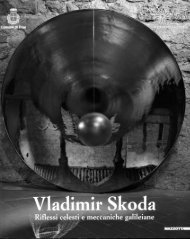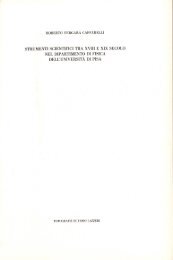La macchina - Il laboratorio di Galileo Galilei
La macchina - Il laboratorio di Galileo Galilei
La macchina - Il laboratorio di Galileo Galilei
- No tags were found...
You also want an ePaper? Increase the reach of your titles
YUMPU automatically turns print PDFs into web optimized ePapers that Google loves.
S = 2,384 mSe invece si usano gli elettromagneti, che sono leggermente più inalto, il percorso èS = 2,400 m<strong>La</strong> massa totale in moto è (M t+ m), dove M t= M 1+ M 2+ M + M cavo+ µ.Si trascura la variabilità della massa M cavo, il cui effetto non è grande.S = (1/2)a t 2S = (1/2) t 2 g’m i/(M t+ m i)g’ = 2S (M t+m i)/m it 2 = 2 x 2,384 (42,806 + m i) / m it 2g’ = 4,768(42,806 + m i) / m it 2Per m 1= 0,5 kgg’ = 2 x 2,384 x 43,306 / 0,5 t 12misure <strong>di</strong> t 1: {6.74; 6.69; 6.73; 6.79; 6.74; 6.76; 6.69; 6.73; 6.63; 6.62}valor me<strong>di</strong>o t 1= 6,71 t 12= 45,024g’ = 412,966/45,024 g’ = 9,17 ms -2Si ripete con il sovrappeso m 2= 1 kgg’ = 2 x 2,384 x 43,805/ t 22misura <strong>di</strong> t 2: {4.69; 4.63; 4.64; 4.67; 4.69; 4.69; 4.62; 4.61; 4.68; 4.65 }valor me<strong>di</strong>o t 2= 4,66 t 22= 21,71630






